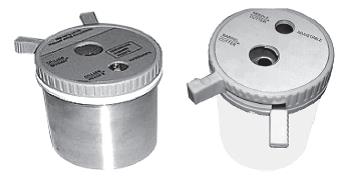
A hub cutter (manual syringe and needle destroyer) is displayed from two different angles in Figure
Identification features
• One or two insertion holes for the syringe
• Two handles (attached to the blades which cut the syringe hub)
• One plastic container (into which the cutoff parts of the syringe and the needle are retained)
What is the use of this?
This is used to destroy the disposable or autodisable (AD) syringe after use.
What is the purpose of using this?
This is used to minimize needlestick injuries to prevent transmission of blood-borne infections such as Hepatitis B and HIV. In other words, this is used to improve injection safety.
Name the relevant program under which it is used.
Reproductive and Child Health (RCH) program under National Health Mission
How is this used?
The needle and the hub of the syringe are inserted into the hole of the hub cutter. The syringe is held with one hand and the other hand is used to clamp the handles until the hub is completely cut and the needle falls into the container.
The hub cutters should be properly washed with at least 1% solution of sodium hypochlorite or freshly prepared bleach solution before reuse
How are the contents of the hub cutter disposed?
The puncture proof container of the hub cutter is carried to the PHC for safe disposal by the CBMWTF
If the CBWTF doesn’t exist, these are disinfected by:
• Autoclaving,
• Boiling in water for at least 10 minutes or
• Chemical treatment for 30 minutes (using at least 1% solution of sodium hypochlorite or freshly prepared bleach solution).
Disinfection is followed by safe disposal as follows:
• The needles and broken vials buried in a safety pit
• The syringes and unbroken vials are sent for recycling or to a landfill
This is done at a site designated for each health care center.
Reference:
GOI. Immunization Handbook for Medical Officers. New Delhi: Department of Health and Family Welfare; 2016.
Terms used in Family Health Study: Definitions and Explanations: http://www.ihatepsm.com/blog/terms-used-family-health-study-definitions-...
